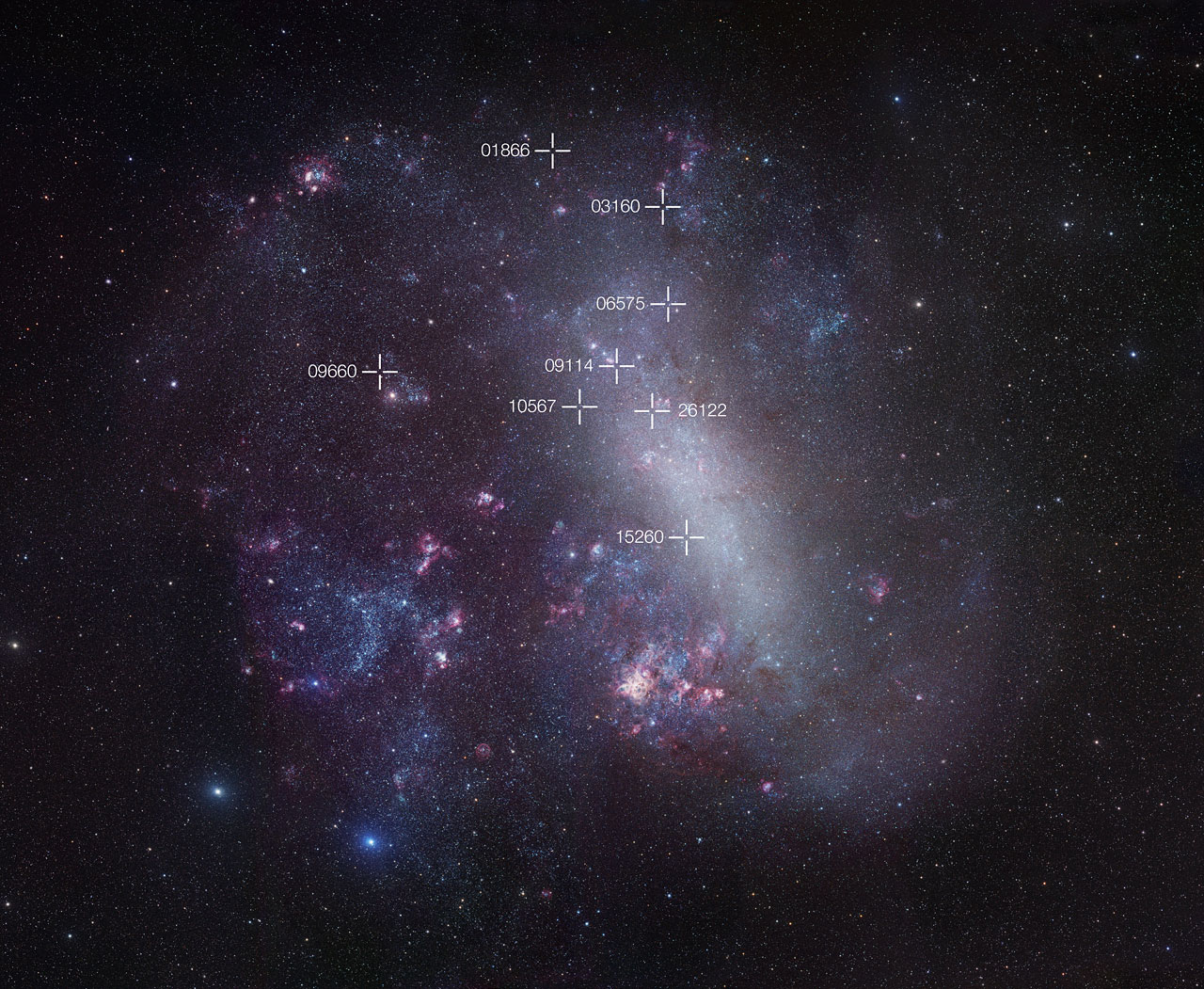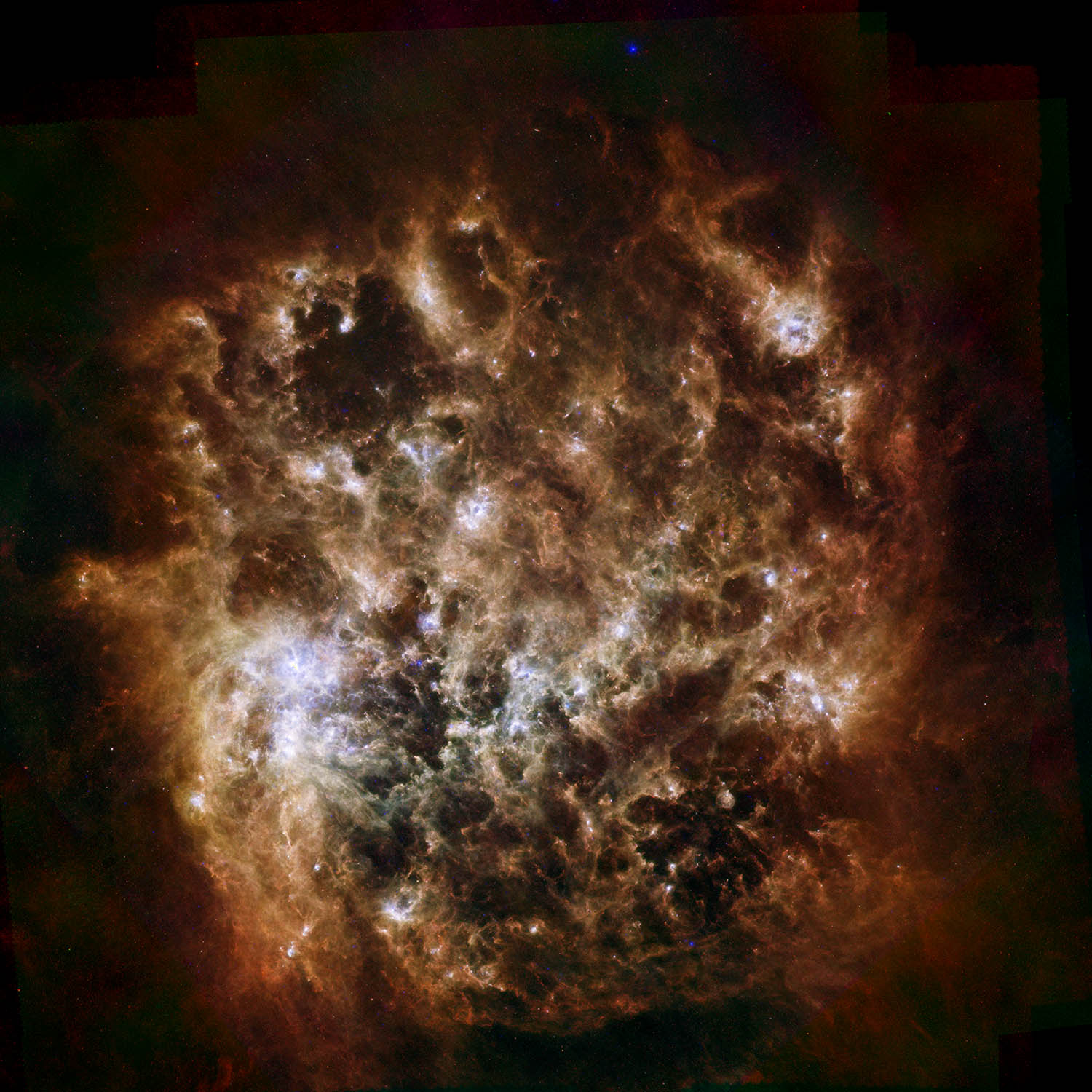European Southern Observatory | Science Release | 2013 Mar 06
New results pin down the distance to the galaxy next door
After nearly a decade of careful observations an international team of astronomers has measured the distance to our neighbouring galaxy, the Large Magellanic Cloud, more accurately than ever before. This new measurement also improves our knowledge of the rate of expansion of the Universe — the Hubble Constant — and is a crucial step towards understanding the nature of the mysterious dark energy that is causing the expansion to accelerate. The team used telescopes at ESO’s La Silla Observatory in Chile as well as others around the globe. These results appear in the 7 March 2013 issue of the journal Nature.
Astronomers survey the scale of the Universe by first measuring the distances to close-by objects and then using them as standard candles [1] to pin down distances further and further out into the cosmos. But this chain is only as accurate as its weakest link. Up to now finding an accurate distance to the Large Magellanic Cloud (LMC), one of the nearest galaxies to the Milky Way, has proved elusive. As stars in this galaxy are used to fix the distance scale for more remote galaxies, it is crucially important.
But careful observations of a rare class of double star have now allowed a team of astronomers to deduce a much more precise value for the LMC distance: 163 000 light-years.
“I am very excited because astronomers have been trying for a hundred years to accurately measure the distance to the Large Magellanic Cloud, and it has proved to be extremely difficult,” says Wolfgang Gieren (Universidad de Concepción, Chile) and one of the leaders of the team. “Now we have solved this problem by demonstrably having a result accurate to 2%.”
The improvement in the measurement of the distance to the Large Magellanic Cloud also gives better distances for many Cepheid variable stars [2]. These bright pulsating stars are used as standard candles to measure distances out to more remote galaxies and to determine the expansion rate of the Universe — the Hubble Constant. This in turn is the basis for surveying the Universe out to the most distant galaxies that can be seen with current telescopes. So the more accurate distance to the Large Magellanic Cloud immediately reduces the inaccuracy in current measurements of cosmological distances.
The astronomers worked out the distance to the Large Magellanic Cloud by observing rare close pairs of stars, known as eclipsing binaries [3]. As these stars orbit each other they pass in front of each other. When this happens, as seen from Earth, the total brightness drops, both when one star passes in front of the other and, by a different amount, when it passes behind [4].
By tracking these changes in brightness very carefully, and also measuring the stars’ orbital speeds, it is possible to work out how big the stars are, their masses and other information about their orbits. When this is combined with careful measurements of the total brightness and colours of the stars [5] remarkably accurate distances can be found.
This method has been used before, but with hot stars. However, certain assumptions have to be made in this case and such distances are not as accurate as is desirable. But now, for the first time, eight extremely rare eclipsing binaries where both stars are cooler red giant stars have been identified [6]. These stars have been studied very carefully and yield much more accurate distance values — accurate to about 2%.
“ESO provided the perfect suite of telescopes and instruments for the observations needed for this project: HARPS for extremely accurate radial velocities of relatively faint stars, and SOFI for precise measurements of how bright the stars appeared in the infrared,” adds Grzegorz Pietrzyński (Universidad de Concepción, Chile and Warsaw University Observatory, Poland), lead author of the new paper in Nature.
“We are working to improve our method still further and hope to have a 1% LMC distance in a very few years from now. This has far-reaching consequences not only for cosmology, but for many fields of astrophysics,” concludes Dariusz Graczyk, the second author on the new Nature paper.
- Notes:
[*] Standard candles are objects of known brightness. By observing how bright such an object appears astronomers can work out the distance — more distant objects appear fainter. Examples of such standard candles are Cepheid variables [2] and Type Ia supernovae. The big difficulty is calibrating the distance scale by finding relatively close examples of such objects where the distance can be determined by other means.
[*] Cepheid variables are bright unstable stars that pulsate and vary in brightness. But there is a very clear relationship between how quickly they change and how bright they are. Cepheids that pulsate more quickly are fainter than those that pulsate more slowly. This period-luminosity relation allows them to be used as standard candles to measure the distances of nearby galaxies.
[*] This work is part of the long-term Araucaria Project to improve measurements of the distances to nearby galaxies.
[*] The exact light variations depend on the relative sizes of the stars, their temperatures and colours and the details of the orbit.
[*] The colours are measured by comparing the brightness of the stars at different near-infrared wavelengths.
[*] These stars were found by searching the 35 million LMC stars that were studied by the OGLE project.
Distance to nearest galaxy measured
Carnegie Institution for Science | 2013 Mar 06
A team of astronomers including Carnegie’s Ian Thompson have managed to improve the measurement of the distance to our nearest neighbor galaxy and, in the process, refine an astronomical calculation that helps measure the expansion of the universe. Their work is published March 7 by Nature.
The Hubble constant is a fundamental quantity that measures the current rate at which our universe is expanding. It is named after 20th Century Carnegie astronomer Edwin P. Hubble, who astonished the world by discovering that our universe has been growing continuously since its inception. Determining the Hubble constant (a direct measurement of the rate of this continuing expansion) is critical for gauging the age and size of our universe. One of the largest uncertainties plaguing past measurements of the Hubble constant has involved the distance to the Large Magellanic Cloud (LMC), our nearest neighboring galaxy, which orbits our own Milky Way.
Astronomers survey the scale of the Universe by first measuring the distances to close-by objects (for example Cepheid variable stars studied by Wendy Freedman, director of the Carnegie Observatories, and her collaborators) and then using observations of these objects in more distant galaxies to pin down distances further and further out in the Universe. But this chain is only as accurate as its weakest link. Up to now finding a precise distance to the LMC has proved elusive. Because stars in this galaxy are used to fix the distance scale for more remote galaxies, an accurate distance is crucially important.
“Because the LMC is close and contains a significant number of different stellar distance indicators, hundreds of distance measurements using it have been recorded over the years,” Thompson said. “Unfortunately, nearly all the determinations have systemic errors, with each method carrying its own uncertainties.”
The international collaboration worked out the distance to the Large Magellanic Cloud by observing rare close pairs of stars, known as eclipsing binaries. These pairs are gravitationally bound to each other, and once per orbit, as seen from Earth, the total brightness from the system drops as each component eclipses its companion. By tracking these changes in brightness very carefully, and also measuring the orbital speeds of the stars, it is possible to work out how big the stars are, how massive they are, and other information about their orbits. When this is combined with careful measurements of the apparent brightness, remarkably accurate distances can be determined.
This method has been used before in taking measurements to the LMC, but with hot stars. As such, certain assumptions had to be made and the distances were not as accurate as desired. This new work, led by Grzegorz Pietrzynski of the Universidad de Concepcion in Chile and Warsaw University Observatory in Poland, used 16-years-worth of observations to identify a sample of intermediate mass binary stars with extremely long orbital periods, perfect for measuring precise and accurate distances.
The team observed eight of these binary systems over eight years, gathering data at Las Campanas Observatory and the European Southern Observatory. The LMC distance calculated using these eight binary stars is purely empirical, without relying on modeling or theoretical predictions. The team refined the uncertainty in the distance to the LMC down to 2.2 percent. This new measurement can be used to decrease the uncertainty in calculations of the Hubble constant to 3 percent, with prospects of improving this to a 2 percent uncertainty in a few years as the sample of binary stars is increased.
Astronomers Measure Distance to Neighbor Galaxy More Accurately Than Ever Before
University of Hawaii | Institute for Astronomy | 2013 Mar 06
ScienceShot: A Better Cosmic Yardstick
Science NOW | Sid Perkins | 2013 Mar 06
An eclipsing-binary distance to the Large Magellanic Cloud accurate to two per cent - G. Pietrzyński et al
- Nature 495(7439) 76 (07 Mar 2013) DOI: 10.1038/nature11878
Rare Eclipsing Binary Stars Provide Refined Measurements in the Universe
Universe Today | Nancy Atkinson | 2013 Mar 06



